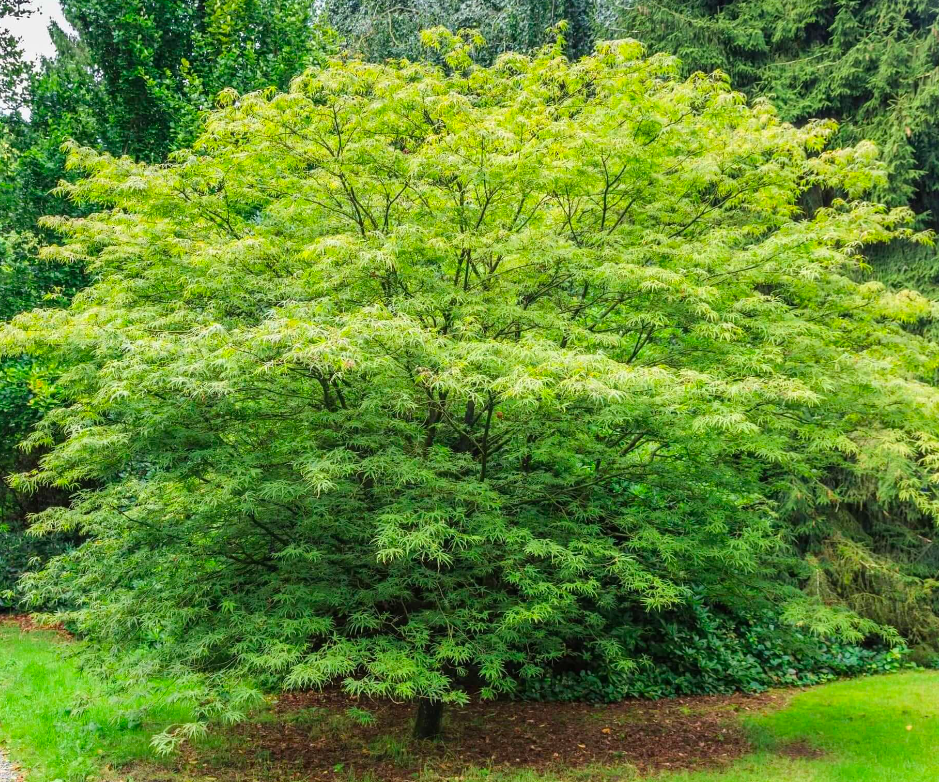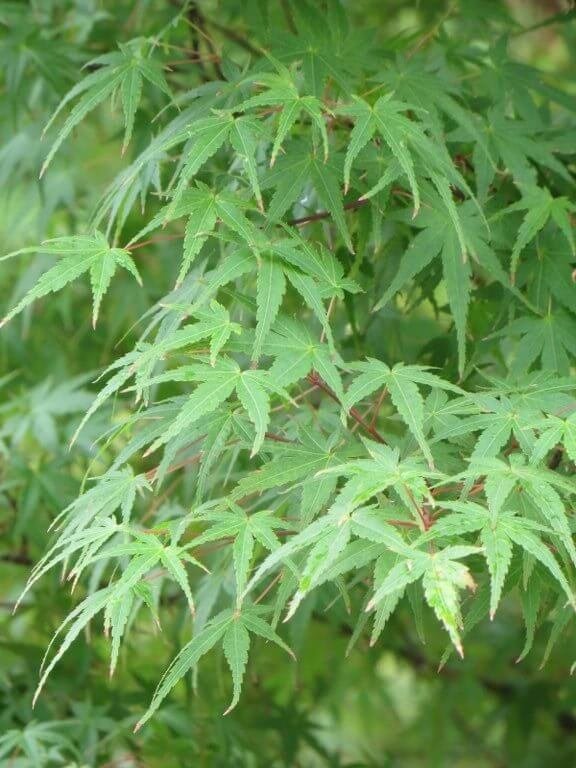 Image 1 of 2
Image 1 of 2

 Image 2 of 2
Image 2 of 2



Japanese Maple Tree Green
Mature Height: 10-25ft
Mature Width: 10-25ft
Exposure: Sun/Part Sun
Hardness Zone: 5-8
Japanese Maple Tree Green (Acer Upright Palmatum) brings a sense of tranquility, sophistication, and natural beauty to any outdoor space, making it a beloved choice among gardeners and landscape enthusiasts. The leaves are typically delicate and finely lobed, with a graceful, almost lacy appearance. The green coloration can vary from a fresh, vibrant spring green to a deeper, more subdued shade as the season progresses. The leaves may have hints of yellow or gold, especially in the fall, adding further dimension to the tree's appearance.
Soil: Japanese maples prefer well-draining, slightly acidic soil with a pH between 5.5 and 6.5. Amend heavy clay soils with organic matter such as compost to improve drainage and fertility.
Planting: Plant your green Japanese maple tree in the spring or fall. Dig a hole that is slightly wider and as deep as the tree's root ball. Gently loosen the roots before planting and backfill the hole with soil, ensuring the tree is planted at the same depth it was in the nursery container.
Watering: Keep the soil consistently moist, especially during the tree's first year after planting. Water deeply but infrequently, allowing the soil to dry slightly between waterings to prevent root rot. Mulching around the base of the tree helps retain moisture and regulate soil temperature.
Fertilizing: Japanese maples benefit from annual fertilization in the spring before new growth emerges. Use a balanced, slow-release fertilizer formulated for acid-loving plants, following the manufacturer's instructions.
Protection: Protect young trees from harsh winter winds and frost damage by wrapping the trunk with burlap or applying a layer of mulch around the base. Consider providing additional protection during extreme weather conditions.
Pests and Diseases: Keep an eye out for common pests such as aphids, scale insects, and spider mites, as well as fungal diseases like powdery mildew and verticillium wilt. Treat any infestations or diseases promptly with appropriate methods, such as insecticidal soap or fungicides.
Mature Height: 10-25ft
Mature Width: 10-25ft
Exposure: Sun/Part Sun
Hardness Zone: 5-8
Japanese Maple Tree Green (Acer Upright Palmatum) brings a sense of tranquility, sophistication, and natural beauty to any outdoor space, making it a beloved choice among gardeners and landscape enthusiasts. The leaves are typically delicate and finely lobed, with a graceful, almost lacy appearance. The green coloration can vary from a fresh, vibrant spring green to a deeper, more subdued shade as the season progresses. The leaves may have hints of yellow or gold, especially in the fall, adding further dimension to the tree's appearance.
Soil: Japanese maples prefer well-draining, slightly acidic soil with a pH between 5.5 and 6.5. Amend heavy clay soils with organic matter such as compost to improve drainage and fertility.
Planting: Plant your green Japanese maple tree in the spring or fall. Dig a hole that is slightly wider and as deep as the tree's root ball. Gently loosen the roots before planting and backfill the hole with soil, ensuring the tree is planted at the same depth it was in the nursery container.
Watering: Keep the soil consistently moist, especially during the tree's first year after planting. Water deeply but infrequently, allowing the soil to dry slightly between waterings to prevent root rot. Mulching around the base of the tree helps retain moisture and regulate soil temperature.
Fertilizing: Japanese maples benefit from annual fertilization in the spring before new growth emerges. Use a balanced, slow-release fertilizer formulated for acid-loving plants, following the manufacturer's instructions.
Protection: Protect young trees from harsh winter winds and frost damage by wrapping the trunk with burlap or applying a layer of mulch around the base. Consider providing additional protection during extreme weather conditions.
Pests and Diseases: Keep an eye out for common pests such as aphids, scale insects, and spider mites, as well as fungal diseases like powdery mildew and verticillium wilt. Treat any infestations or diseases promptly with appropriate methods, such as insecticidal soap or fungicides.
Mature Height: 10-25ft
Mature Width: 10-25ft
Exposure: Sun/Part Sun
Hardness Zone: 5-8
Japanese Maple Tree Green (Acer Upright Palmatum) brings a sense of tranquility, sophistication, and natural beauty to any outdoor space, making it a beloved choice among gardeners and landscape enthusiasts. The leaves are typically delicate and finely lobed, with a graceful, almost lacy appearance. The green coloration can vary from a fresh, vibrant spring green to a deeper, more subdued shade as the season progresses. The leaves may have hints of yellow or gold, especially in the fall, adding further dimension to the tree's appearance.
Soil: Japanese maples prefer well-draining, slightly acidic soil with a pH between 5.5 and 6.5. Amend heavy clay soils with organic matter such as compost to improve drainage and fertility.
Planting: Plant your green Japanese maple tree in the spring or fall. Dig a hole that is slightly wider and as deep as the tree's root ball. Gently loosen the roots before planting and backfill the hole with soil, ensuring the tree is planted at the same depth it was in the nursery container.
Watering: Keep the soil consistently moist, especially during the tree's first year after planting. Water deeply but infrequently, allowing the soil to dry slightly between waterings to prevent root rot. Mulching around the base of the tree helps retain moisture and regulate soil temperature.
Fertilizing: Japanese maples benefit from annual fertilization in the spring before new growth emerges. Use a balanced, slow-release fertilizer formulated for acid-loving plants, following the manufacturer's instructions.
Protection: Protect young trees from harsh winter winds and frost damage by wrapping the trunk with burlap or applying a layer of mulch around the base. Consider providing additional protection during extreme weather conditions.
Pests and Diseases: Keep an eye out for common pests such as aphids, scale insects, and spider mites, as well as fungal diseases like powdery mildew and verticillium wilt. Treat any infestations or diseases promptly with appropriate methods, such as insecticidal soap or fungicides.
